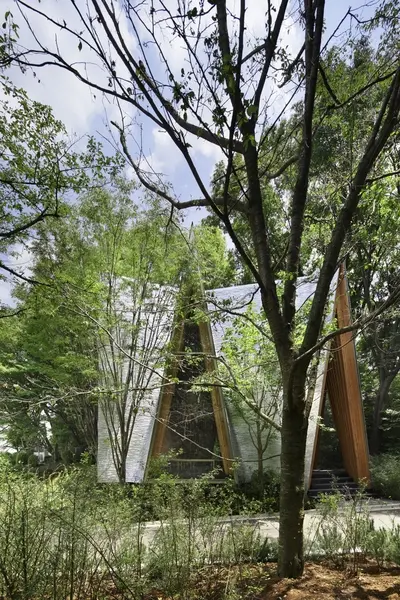狭山森林小教堂

下载所需积分: 2
狭山湖畔公墓公园坐落在狭山丘陵的郁郁葱葱的环境中。
在庆祝其40周年之际,公墓公园决定重建其教堂和社区大厅。我们在设计竞赛中从多家公司中脱颖而出,成为最终的选择。
狭山湖畔公墓公园教堂位于公墓的边界,毗邻一片深林。我们相信,所有访客无论宗教信仰如何,都会对安息者所处的森林怀有相似的情感,因此我们希望创造一个面向森林的祈祷空间,坐落在树木之间。为了让教堂与森林亲密相连,我们在公墓一侧种植了树木,并设计了一座与周围树木融为一体的建筑。
为了避开树木及其树枝,我们将外墙向内倾斜。这导致了一个“合掌” “双手合十” 风格的建筑,由成对的斜屋架 “顶部连接的斜梁” 构成。传统的合掌结构除了成对的屋架外,还需要抗震墙,但通过进一步发展这种全方位的斜屋架结构,适应树木之间的空间,我们使屋顶结构能够自我支撑水平和垂直负荷。因此,原本认为是桁架系统屋顶所必需的抗震墙可以被省略,从而获得了一种更简单、更现代的合掌风格建筑。
为了防止弯曲,屋架使用结构胶合板加固。我们选择了60mm的细长屋架,并将其角落修整为9R的曲率,使结构的内部外观呈现出精致的饰面材料感。屋脊梁和所有金属连接件被隐藏,给人一种屋架从地面上升起的简单印象。最终形成了一种更简单、更现代的合掌结构,仅由连续的屋架序列构成。柔和的树影过滤的阳光透过251根屋顶的屋架,照亮了内部空间。
为了确保教堂的长期耐用性和持久性,我们采用了随机切割的铝瓦,铸造于铸造厂。瓦片厚度为4mm,这是耐用性的最小厚度和根据屋顶曲率手工弯曲的最大厚度。地面采用天然石材 “Inai-ishi板岩” 铺成,表面有石头劈裂留下的粗糙纹理。就像铝屋顶瓦片上可见的流动痕迹一样,地面石材在外观上暗示了超越人类控制的自然力量。正如我们积极寻求将阳光和其他自然现象引入内部空间,我们也努力通过材料的纹理表达自然现象。我认为,与超越人类事务的广阔神秘建立这样的对话是教堂的合适之处。
地面在祭坛一侧略微向森林倾斜。地面石材的接缝也沿着放射线朝向森林深处的消失点延伸。当访客进入建筑时,他们会不自觉地朝向森林移动。当一个人双手合十祈祷时,手掌之间会形成一个小而温暖的空间。我们将这个小小的祈祷空间具象化为建筑。因此,这是一座与访客共同祈祷的教堂。
由于251根日本落叶松屋架的长度和方向各不相同,我们在数控车床上根据精确的3D建模数据进行切割,最大长度达到9米,误差范围控制在3mm以内。由于成对的屋架是独立的,一个支撑另一个,我们在其上端插入连接板,并用漂移销固定。这样预先连接的成对屋架形成一个倒V形,被吊起并放置到位。为了将屋架连接到基板,我们在每根屋架的底部切割圆孔,以便将其安装在从基板突出的圆杆上。然后通过圆杆上的孔将漂移销敲入已安装的屋架。我们担心在任何微小的偏差下,可能会很难将成对屋架的两个脚连接到基板上。然而,通过开发一个特殊的夹具,我们能够将屋架与基板的圆杆之间的偏差限制在1mm以内。因此,尽管在施工过程中遇到了一系列困难,我们仍然实现了一个纯粹形式的合掌结构。
Sayama Lakeside Cemetery Park is situated in the verdant surroundings in the Sayama hills.
In marking its 40th anniversary, the Cemetery Park decided to rebuild its chapel and community hall. We were chosen from among several firms in a design competition.
Sayama Lakeside Cemetery Park Chapel stands by the cemetery’s boundary adjacent to a deep forest. In believing that all visitors would hold similar feelings toward the forest where the deceased sleep regardless of their religious beliefs, we sought to produce a space for offering prayers toward the forest, nestled among the trees. To give the chapel intimacy with the forest, we planted trees on the cemetery side, and designed a building that merges with its encompassing trees.
So as to avoid the trees and their branches, we tilted the outer walls inward. This resulted in a gassho (“hands in prayer”) style building, formed of pairs of sasu (sloping rafters joined together at the top). The traditional gassho structure also requires seismic walls in addition to the paired rafters, but by further developing this style in an omnidirectional sasu structure, fitted into spaces among the trees, we enabled the roof structure to self-support horizontal as well as vertical loads. As a result, the seismic wall which was thought to be a necessity for a truss-system roof could be eliminated, and we obtained a gassho style building of a simpler and more contemporary form.
To prevent buckling, the rafters were made rigid using structural plywood. By choosing a slender 60mm width for the rafters and beveling their corners to radius 9R curvature, we imparted the fineness of a finish material to the structure’s interior appearance. The ridge beam and all metal connections are hidden to produce an impression simply of rafters rising from the floor. The result, a simpler, more contemporary gassho structure formed only of continuous sequence of rafters. Soft tree-filtered sunlight penetrates through the 251 rafters of the roof to animate its interior space.
To ensure long durability and permanence of the chapel, we applied random-cut aluminum tiles, sand-cast at a foundry. The tiles are 4mm thick, the minimum thickness for durability and maximum thickness for bending them by hand according to the curvature of the roof. The floor is finished with a natural stone (Inai-ishi slate) which has a rough texture from the wedge marks by stone-splitting. Like the flow marks visible on the aluminum roof tiles, the floor stones suggest (in appearance) the power of nature beyond human control. Just as we actively sought to draw sunlight and other natural phenomena into the interior space, we also endeavored to express natural phenomena through texture on a material level. I felt that establishing such dialogue with the vast mystery beyond human affairs was suitable for a chapel.
The floor inclines slightly toward the forest on the altar side. The joints of the floor stones also run radially in lines toward a vanishing point deep in the forest. Upon entering the building, visitors move unconsciously toward the forest. When a person clasps hands to pray with fingers locked, a small, warm space forms between their palms. We took this small prayerful space and embodied it in a building. It is a chapel, thus, that prays together with the visitors.
Because each of the 251 Japanese larch rafters differs in length and orientation, we cut them on a numerically-controlled lathe based on the precise 3-D modeling data, and produced them within a 3mm error range even with their maximum 9m length. Since the paired rafters are freestanding with one supporting the other, we inserted a connecting plate into their upper end and secured the plate with drift pins. The paired rafters, thus pre-connected and forming an upside-down V were hoisted and dropped into position. To join the rafters to the base plate, round holes were cut in the foot of each rafter for mounting them on round bars protruding from the base plate. A drift pin was then knocked into the mounted rafter through a hole in the round bar. There was a concern that it might be difficult to connect both feet of the paired rafters to the base plate with any slight discrepancy. However, by developing a special jig, we could limit the variance between the rafter and the round bar of the base plate to 1mm. As a result, despite a succession of difficulties hindering the construction process, we achieved a gassho structure of pure form.